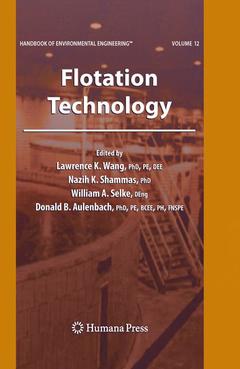Description
Flotation Technology, Softcover reprint of the original 1st ed. 2010
Volume 12
Handbook of Environmental Engineering Series, Vol. 12
Coordinators: Wang Lawrence K., Shammas Nazih K., Selke William A., Aulenbach Donald B.
Language: English
Subject for Flotation Technology:
Flotation Technology
Publication date: 08-2016
Support: Print on demand
Publication date: 08-2016
Support: Print on demand
Flotation technology (hardback) book (series: handbook of environmental engineering, vol 12) POD
Publication date: 06-2010
680 p. · 17.8x25.4 cm · Hardback
Publication date: 06-2010
680 p. · 17.8x25.4 cm · Hardback
Description
/li>Contents
/li>Comment
/li>
The past 30 years have seen the emergence of a growing desire worldwide that positive actions be taken to restore and protect the environment from the degrading effects of all forms of pollution ? air, water, soil, and noise. Since pollution is a direct or indirect consequence of waste, the seemingly idealistic demand for ?zero discharge? can be construed as an unreal- tic demand for zero waste. However, as long as waste continues to exist, we can only attempt to abate the subsequent pollution by converting it to a less noxious form. Three major questions usually arise when a particular type of pollution has been identi?ed: (1) How serious is the pollution? (2) Is the technology to abate it available? and (3) Do the costs of abatement justify the degree of abatement achieved? This book is one of the volumes of the Handbook of Environmental Engineering series. The principal intention of this series is to help readers formulate answers to the last two questions above. The traditional approach of applying tried-and-true solutions to speci?c pollution p- blems has been a major contributing factor to the success of environmental engineering and has accounted in large measure for the establishment of a ?methodology of pollution control. ? However, the realization of the ever-increasing complexity and interrelated nature of current environmental problems renders it imperative that intelligent planning of pollution abatement systems be undertaken.
Principles of Air Flotation Technology.- Gas Dissolution, Release, and Bubble Formation in Flotation Systems.- Separation of Oil from Wastewater by Air Flotation.- Fundamentals of Wastewater Flotation.- Electroflotation.- Wastewater Treatment by Electrocoagulation–Flotation.- Treatment of Paper Mill Whitewater, Recycling and Recovery of Raw Materials.- Ozone–Oxygen Oxidation Flotation.- Wastewater Renovation by Flotation.- Flotation–Filtration System for Wastewater Reuse.- Algae Removal by Flotation.- Completely Closed Water Systems in Paper Mills.- Lake Restoration Using Dissolved Air Flotation.- Jiminy Peak, Hancock, Massachusetts Wastewater Treatment Plant: The First RBC-Flotation-UV Wastewater Treatment Plant in the USA.- Pittsfield Water Treatment Plant: Once the World’s Largest Flotation–Filtration Plant.- Pretreatment of Meat-Processing Waste.- Treatment of Seafood Processing Wastewater.- Laboratory Simulation and Testing of Air Flotation and Associated Processes.
Coverage of the principles of air flotation technology and the fundamentals of water and wastewater flotation and lake restoration. Emphasis on industry standards, trends in the field, full-scale operation and laboratory simulation of air flotation processes. Examples of actual operating water and wastewater treatment plants based on air flotation Reference of practical use to scientists, researchers, educators and designers of water and wastewater treatment systems. Includes supplementary material: sn.pub/extras
© 2024 LAVOISIER S.A.S.
These books may interest you

Environmental Biotechnology 295.39 €



